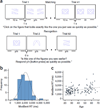Enhancing dentate gyrus function with dietary flavanols improves cognition in older adults
- PMID: 25344629
- PMCID: PMC4940121
- DOI: 10.1038/nn.3850
Enhancing dentate gyrus function with dietary flavanols improves cognition in older adults
Abstract
The dentate gyrus (DG) is a region in the hippocampal formation whose function declines in association with human aging and is therefore considered to be a possible source of age-related memory decline. Causal evidence is needed, however, to show that DG-associated memory decline in otherwise healthy elders can be improved by interventions that enhance DG function. We addressed this issue by first using a high-resolution variant of functional magnetic resonance imaging (fMRI) to map the precise site of age-related DG dysfunction and to develop a cognitive task whose function localized to this anatomical site. Then, in a controlled randomized trial, we applied these tools to study healthy 50-69-year-old subjects who consumed either a high or low cocoa flavanol-containing diet for 3 months. A high-flavanol intervention was found to enhance DG function, as measured by fMRI and by cognitive testing. Our findings establish that DG dysfunction is a driver of age-related cognitive decline and suggest non-pharmacological means for its amelioration.
Figures





Comment in
-
Flavanol-rich food for thought.Nat Neurosci. 2014 Dec;17(12):1624-5. doi: 10.1038/nn.3876. Nat Neurosci. 2014. PMID: 25413084 Free PMC article.
Similar articles
-
Flavanol-rich food for thought.Nat Neurosci. 2014 Dec;17(12):1624-5. doi: 10.1038/nn.3876. Nat Neurosci. 2014. PMID: 25413084 Free PMC article.
-
Benefits in cognitive function, blood pressure, and insulin resistance through cocoa flavanol consumption in elderly subjects with mild cognitive impairment: the Cocoa, Cognition, and Aging (CoCoA) study.Hypertension. 2012 Sep;60(3):794-801. doi: 10.1161/HYPERTENSIONAHA.112.193060. Epub 2012 Aug 14. Hypertension. 2012. PMID: 22892813 Clinical Trial.
-
The effect of acute cocoa flavanol intake on the BOLD response and cognitive function in type 1 diabetes: a randomized, placebo-controlled, double-blinded cross-over pilot study.Psychopharmacology (Berl). 2019 Dec;236(12):3421-3428. doi: 10.1007/s00213-019-05306-z. Epub 2019 Jun 25. Psychopharmacology (Berl). 2019. PMID: 31236643 Clinical Trial.
-
Chocolate and the brain: neurobiological impact of cocoa flavanols on cognition and behavior.Neurosci Biobehav Rev. 2013 Dec;37(10 Pt 2):2445-53. doi: 10.1016/j.neubiorev.2013.06.013. Epub 2013 Jun 26. Neurosci Biobehav Rev. 2013. PMID: 23810791 Review.
-
How to make a hippocampal dentate gyrus granule neuron.Development. 2014 Jun;141(12):2366-75. doi: 10.1242/dev.096776. Development. 2014. PMID: 24917496 Review.
Cited by
-
The Potential Effects of Red Wine and Its Components on Neurocognitive Disorders: A Narrative Review.Nutrients. 2024 Oct 10;16(20):3431. doi: 10.3390/nu16203431. Nutrients. 2024. PMID: 39458427 Free PMC article. Review.
-
Cacao Ameliorates Amyloid Beta-Induced Cognitive and Non-Cognitive Disturbances.Neurosci Insights. 2024 Sep 17;19:26331055241280638. doi: 10.1177/26331055241280638. eCollection 2024. Neurosci Insights. 2024. PMID: 39314637 Free PMC article.
-
Flavonoids as Potential Therapeutics Against Neurodegenerative Disorders: Unlocking the Prospects.Neurochem Res. 2024 Aug;49(8):1926-1944. doi: 10.1007/s11064-024-04177-x. Epub 2024 Jun 1. Neurochem Res. 2024. PMID: 38822985 Review.
-
Cacao consumption improves passive avoidance memory impairment in a rat model of Alzheimer's disease: the role of hippocampal synaptic plasticity and oxidative stress.Front Pharmacol. 2024 May 2;15:1379264. doi: 10.3389/fphar.2024.1379264. eCollection 2024. Front Pharmacol. 2024. PMID: 38756381 Free PMC article.
-
Association between Flavonoid Intake and Cognitive Executive Function among African American and White Adults in the Healthy Aging in Neighborhoods of Diversity across the Life Span (HANDLS) Study.Nutrients. 2024 Apr 30;16(9):1360. doi: 10.3390/nu16091360. Nutrients. 2024. PMID: 38732605 Free PMC article.
References
-
- Gazzaley A, Cooney JW, Rissman J, D’Esposito M. Top-down suppression deficit underlies working memory impairment in normal aging. Nat. Neurosci. 2005;8:1298–1300. - PubMed
-
- Small SA, Stern Y, Tang M, Mayeux R. Selective decline in memory function among healthy elderly. Neurology. 1999;52:1392–1396. - PubMed
-
- Small SA, Tsai WY, DeLaPaz R, Mayeux R, Stern Y. Imaging hippocampal function across the human life span: is memory decline normal or not? Ann. Neurol. 2002;51:290–295. - PubMed
Publication types
MeSH terms
Substances
Grants and funding
LinkOut - more resources
Full Text Sources
Other Literature Sources

